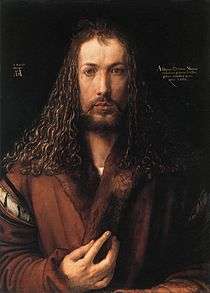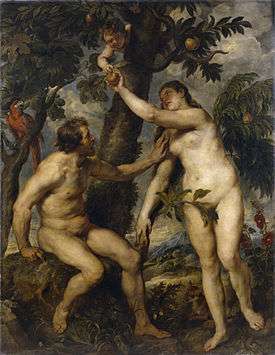Adam and Eve (Dürer)
| Adam and Eve | |
|---|---|
_2.jpg) | |
| Artist | Albrecht Dürer |
| Year | 1507 |
| Medium | Oil on panel |
| Dimensions | Two panels, each 209 cm × 81 cm (82 in × 32 in) |
| Location | Museo del Prado, Madrid |
Adam and Eve is a pair of oil-on-panel paintings by German Renaissance artist Albrecht Dürer.
Completed in 1507, the work followed a 1504 copper engraving by Dürer on the same subject, one which offered Dürer the opportunity to depict the ideal human figure. Painted in Nuremberg soon after his return from Venice, the panels were influenced by Italian art. Dürer's observations on his second trip to Italy provided him with new approaches to portraying the human form. Here, he depicts Adam and Eve at human scale—the first full-scale nude subjects in German painting.
Adam and Eve's first home was the Prague Castle, the property of collector Rudolf II. During the Thirty Years' War, armies plundered the castle and the panels came to be owned by Gustavus Adolphus of Sweden. His daughter, Christina, gave the work to Philip IV of Spain in 1654. Later King Charles III ordered in 1777 that the painting be hidden in the Real Academia de Bellas Artes de San Fernando. It arrived at its current home, Madrid's Museo del Prado, in 1827, but was not publicly displayed until 1833.
See also
Sources
- Nürnberg, Verlag Hans Carl. Dürer in Dublin: Engravings and woodcuts of Albrecht Dürer. Chester Beatty Library, 1983
- Hart, Vaughan. Navel Gazing. On Albrect Dürer's Adam and Eve (1504), The International Journal of Arts Theory and History, 2016, vol.12.1 pp.1-10

